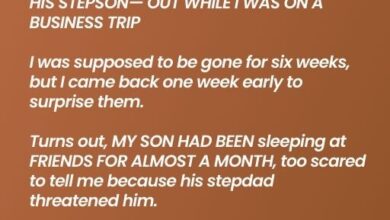
Tattooed woman who keeps her nose in a jar reveals what she looked like before
Social media is buzzing over the dramatic transformation of a body-modification enthusiast known online as Toxii. In just four years, she’s gone from a glam, blonde, no-tattoos look to one of the most extreme aesthetic identities on the internet—jet-black hair, full upper-body blackout tattoos, eye and tongue ink, a split tongue, horn-style forehead implants, and a surgically removed nose that she openly says she keeps preserved in a jar. Her latest before-and-after post exploded across feeds, forcing a blunt conversation about autonomy, identity, and how much control any of us should have over our appearance.
In her 2019 “before” photo, she’s almost unrecognizable: long blonde waves, full makeup, and not a visible tattoo in sight. Fast-forward to today and she’s purposefully, defiantly different—minimal outfits that frame heavy blackwork ink, high-contrast styling, and facial modifications that push beyond conventional beauty norms. The intent isn’t subtle: she’s building a public persona that refuses to pass quietly.
Asked why she’s gone this far, her answer is as direct as it gets: “I like to be imperfect, and I think imperfections make you unique.” That line has become the thesis of her brand. With nearly 160,000 followers on Instagram and clips circulating on TikTok, YouTube, and X, her feed is a steady stream of unapologetic self-presentation—studio portraits, street-style videos, and interviews where she matter-of-factly explains procedures most people only doom-scroll past.
In a widely shared sidewalk interview with artist Devon Rodriguez, she broke down the pain scale of some of her headline-grabbing changes. The forehead implants? “Didn’t hurt.” The nose removal? “Way worse,” she said, adding it took roughly eight weeks to heal. When Rodriguez asked the obvious question—did she keep the nose?—she barely blinked: “I have all my body parts, in little jars.” For her, archiving the journey is part documentary, part ownership, and fully on brand.
The internet’s reaction, predictably, spans admiration to outrage. Supporters see a daring artist in full control of her canvas, praising her confidence, coherence of vision, and the way she confronts beauty rules head-on. They argue that extreme modification is simply the far edge of a spectrum that already includes piercings, fillers, and cosmetic surgery. If autonomy is the principle, where we personally draw the line is taste—not policy.
Critics fire back with equal force. Some mourn the “before,” insisting she was “so beautiful” and lamenting what they frame as irreversible loss. Others speculate about mental health, spirituality, or shock value. A few go off the rails with accusations of “possession” or “ritual,” projecting superstition onto what is, at core, a set of surgical and tattoo decisions carried out by adults. Another camp warns about speed: changes this significant, they argue, deserve years of deliberation to reduce the risk of regret.
That tension—admiration versus alarm—says more about us than it does about her. Body modification has always been a mirror. From ear piercing to microblading, from rhinoplasty to blackout sleeves, we tinker with ourselves to feel aligned with the person inside. Toxii’s case just turns the volume to max. She’s not chasing invisibility; she’s building an unmistakable identity and living with the consequences in public.
There’s also a platform dynamic here that’s impossible to ignore. Social media rewards extremes—clear narratives, high-contrast visuals, fast transformations. A four-year flip from glam blonde to blackout, horned, and noseless is the kind of “scroll-stopping” arc algorithms devour. But the same visibility invites mass judgment, and she clearly understood that when she hit post. Whether you love or hate her look, she’s set the terms of engagement: no apology, no permission-seeking, no soft-focus filter to make it palatable.
If you strip the viral heat and look at the story structurally, a few themes stand out:
Personal agency. She is a consenting adult making choices about her body. That’s the baseline. You don’t need to like her choices to recognize her right to make them.
Aesthetic coherence. This isn’t a random collage of stunts. The blackout ink, ocular tattoos, tongue split, and subdermal implants build a unified silhouette—graphic, biomechanical, almost sculptural. You can disagree with the goal and still acknowledge the design discipline.
Pain, risk, and aftercare. She’s the first to say the nose removal was painful and the recovery lengthy. Any permanent modification of this scale carries medical risk and demands responsible aftercare. For outsiders, this is a reminder that “extreme” looks are often years of planning, clinics, healing cycles, and money.
Public reception. Praise, backlash, speculation—none of it seems to move her. That detachment is part of the persona. She isn’t campaigning for mainstream acceptance; she’s modeling radical permission.
Cultural friction. Her transformation throws our norms into sharp relief. We applaud reinvention until it crosses an invisible line—then we demand explanations. She refuses the pop-psych soundbite. The explanation is simple: “Because I like it.”
The criticisms deserve a straight answer too. “You were prettier before.” That’s taste. “This must be mental illness.” That’s an armchair diagnosis and not your call. “It’s impulsive.” From her own timeline, it wasn’t—this was staged over years, with staged procedures and recovery windows. If you care about bodily autonomy, you don’t yank it back when the result offends you.
There’s also a practical reason this story lands so hard: facial change is emotionally loaded. We’re wired to read faces for recognition, empathy, and trust. When someone edits their face beyond the bounds we expect, it can feel unsettling. But discomfort is not harm. Recognize the difference.
If you’re new to this world and genuinely curious, here’s what to understand about the specific modifications she’s discussed:
Blackout tattoos. Large, saturated fields of black ink used to cover skin completely, often for a bold graphic effect or to unify older tattoo work. This is a multi-session, high-commitment choice that requires an experienced artist.
Ocular (eye) tattooing. Dye is injected into the sclera. It is permanent and carries real medical risk if performed by unqualified practitioners. This is not a DIY trend.
Tongue split. A surgical division of the tongue to create a forked appearance. It demands professional execution and diligent aftercare.
Subdermal implants. Shaped objects placed under the skin to create raised contours (in her case, horn-like ridges). Placement, material, and sterility matter.
Rhinotomy (nose removal). A radical facial surgery that permanently changes airway dynamics, appearance, and daily life, followed by prolonged healing. It is not comparable to cosmetic rhinoplasty.
None of this is casual. It’s a full-contact approach to self-expression, and the person living with it is fully aware of that reality.
So is this a bold celebration of personal freedom or a symptom of a culture obsessed with image? Both critiques miss the center. The point isn’t whether you’d do it. The point is whether an adult can design their body without being reduced to a diagnosis or a morality play. You can disagree with the aesthetic and still hold the line on autonomy. You can also admit the obvious: she’s unforgettable. That’s not a bug of her strategy—it’s the feature.
If you take anything from the uproar, let it be this: your standards are yours; hers are hers. The internet conflates visibility with consent to be judged. It isn’t. What she’s asked for is narrow and nonnegotiable—room to exist as she chooses. That’s it.
And that’s likely why this story won’t fade. In a feed stuffed with interchangeable faces and filters, she’s built an identity you cannot scroll past. Whether you label it art, rebellion, or excess, the conversation she’s forcing—about autonomy, design, pain, and permission—was overdue. You don’t have to like the look to understand the lesson.




